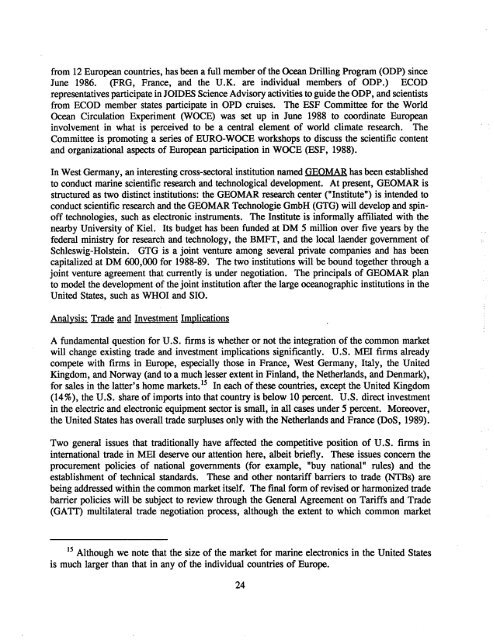WHOI-90-52
WHOI-90-52
WHOI-90-52
Create successful ePaper yourself
Turn your PDF publications into a flip-book with our unique Google optimized e-Paper software.
from 12 Europe countres, has been a full member of the Oc Drillng Program (ODP) since<br />
June 1986. (FRG, France, and the U.K. are individua members of ODP.) ECOD<br />
representatives paricipate in JOIDES Science Advisory activities to guide the ODP, and scientists<br />
from ECOD member states paricipate in OPD cruises. The ESF Committee for the World<br />
Ocea Circulation Experiment (WOCE) was set up in June 1988 to coordinate Europe<br />
involvement in what is perceived to be a central element of world climate resech. The<br />
Committee is promoting a series of EURO-WOCE workshops to discuss the scientific content<br />
and organizational aspets of Europe parcipation in WOCE (ESF, 1988).<br />
In West Germany, an interesting cross-setoral institution named GEOMAR has been established<br />
to conduct marne scientific resech and tehnologica development. At present, GEOMAR is<br />
structured as two distinct institutions: the GEOMAR resech center ("Institute") is intended to<br />
conduct scientific resech and the GEOMAR Technologie GmbH (GTG) wil develop and spinoff<br />
tehnologies, such as electronic instruments. The Institute is informally affiliate with the<br />
neaby University of KieL. Its budget has been funded at DM 5 millon over five yeas by the<br />
federal ministry for reseach and technology, the BMFT, and the local laender government of<br />
Schleswig-Holstein. GTG is a joint venture among several private companies and has been<br />
capitaized at DM 60,00 for 1988-89. The two institutions wil be bound together through a<br />
joint venture agreement that currently is under negotiation. The principals of GEOMAR plan<br />
to model the development of the joint institution after the large ocographic institutions in the<br />
United States, such as <strong>WHOI</strong> and SIO.<br />
Analysis: Trade and Investment Implications<br />
A fundamenta question for U.S. firms is whether or not the integration of the common market<br />
wil change existing trade and investment implications significatly. U.S. MEI firms already<br />
compete with firms in Europe, espeially those in France, West Germany, Itay, the United<br />
Kingdom, and Norway (and to a much lesser extent in Finland, the Netherlands, and Denmark),<br />
15 In each of these countres, except the United Kingdom<br />
for saes in the latter's home markets.<br />
(14%), the U.S. share of imports into that countr is below 10 percent. U.S. direct investment<br />
in the electrc and electronic equipment setor is small, in all cases under 5 percent. Moreover,<br />
the United States has overall trade surpluses only with the Netherlands and France (DoS, 1989).<br />
Two general issues that traditionally have affected the competitive position of U.S. firms in<br />
international trade in MEI deserve our attention here, albeit briefly. These issues concern the<br />
procurement policies of national governments (for example, "buy national" rules) and the<br />
establishment of technical stadards. These and other nontaff barers to trade (NBs) are<br />
being addresse within the common market itself. The final form of revise or harmonized trade<br />
barer policies wil be subject to review through the General Agreement on Tarffs and Trade<br />
(GATT) multilateral trade negotiation process, although the extent to which common market<br />
15 Although we note that the size of the market for marne electronics in the United States<br />
is much larger than that in any of the individual countries of Europe.<br />
24
















